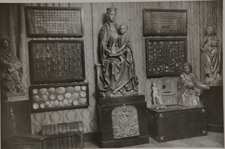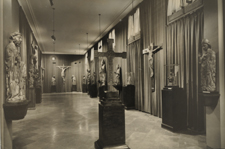

The origin of the Museu Frederic Marès dates back to 1946. Two years earlier, in 1944, Marès had held the first public presentation of his collection at the headquarters of what is today the City History Archive in the heart of Barcelona's Roman and Gothic district. This display included mediaeval and Baroque sculpture, clocks, reliquaries, incunabula and a whole host of objects that until then he had stored in his study on Mallorca street. At that time, he announced his desire to offer the collection to the city of Barcelona. Frederic Marès was 51 years old at the time, which is meaningful because he died at the age of almost 99, which enabled him to keep enlarging his collections. A mere two years later, in 1948, what can be regarded as the first hall of the museum was opened, housed on the first floor of a building on Comtes street.
In the Middle Ages this building and others near it had housed some of the quarters of the Royal Palace of the Counts of Barcelona. In the 1940s, the Town Hall decided to install the museum there in order to bring it into what since then has been called the Gothic Quarter, the old heart of the city located in the environs of the cathedral. This area had been recovered as the city's historic centre since 1929, the year of the International Exposition.
As soon as the museum could no longer grow because a lack of space, Marès started what we could call a decentralising policy in which he either made donations to other museums or created new ones. The donations included the ones he made to the Museu de l'Empordà in Figueres, the Museu d'Història in Sabadell and the Museo de la Real Academia de Bellas Artes de San Fernando in Madrid. As for creating new museums, they include the Museu Frederic Marès de Montblanc, in Montblanc, the Museu d'Arenys de Mar and the Museu del Llibre Frederic Marès in Barcelona's Library of Catalonia.
In 1997, a museographic plan was drawn up aimed at adapting the museum to the needs of the 21st century. The construction work in the first phases of remodelling, which affected the ground and the underground floor which housed sculpture and involved opening a temporary exhibition hall that had not existed until then, was started in April 1999 and in 2001.
In the third phase of this museographic project finished in 2011, the first floor will be remodelled, thus completing the presentation of the sculpture collections and the main architectural features connecting the different floors of the museum.